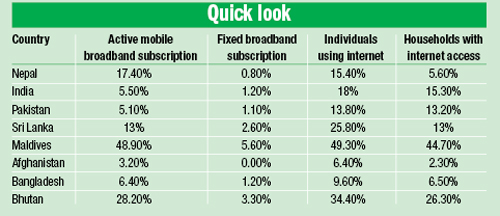‘Nepal has 17pc active mobile broadband users’
Kathmandu, September 24
A report on the global state of broadband has revealed that Nepal’s active mobile broadband subscription has reached 17.4 per cent per 100 inhabitants. With this, the country has ranked higher than its South Asian neighbours — India, Pakistan, Sri Lanka, Bangladesh and Afghanistan.
Produced annually by the Broadband Commission for Digital Development, The State of Broadband report is a unique global snapshot of broadband network access. The 2015 edition says that Maldives is leading in broadband access in South Asia, followed by Bhutan. Maldives’s mobile broadband subscription is at 48.9 per cent and of Bhutan at 28.2 per cent.
In global ranking, Nepal stands at 115th position in mobile broadband subscription, 139th in fixed broadband subscription with 0.8 per cent, and has taken internet to 5.6 per cent of the households of the country. Similarly, as per the report, country’s 15.4 per cent population has access to internet. Last year, Nepal’s active mobile subscription rate was 13 per cent.
“Countries need to adopt effective policies and strategies to make broadband available, affordable and accessible, as a vital enabler of sustainable development in modern-day knowledge societies,” reads the report released recently by the Broadband Commission. The commission was set up jointly by International Telecommunication Union (ITU) and the United Nations Organisation for Education, Science and Culture (UNESCO) in 2010.
Since the broadband connectivity has potential to serve as a major accelerator of development, the government has focused on increasing its reach and making it cheaper in the Broadband Policy 2015 and National ICT Policy 2015. Experts say that the country has witnessed good progress in mobile broadband due to growth in 3G users. However, other countries have outpaced Nepal in increasing broadband penetration and reaping benefits from it.
“We need to be more focused on quality and price, besides making available local content for meaningful use of broadband,” said Manohar Kumar Bhattarai, an ICT expert, who had drafted Broadband Policy and ICT Policy as consultant to the government. He said the growth in wireless broadband was inevitable and government should also promote fixed broadband connection and make it reliable and affordable.
In the Broadband Policy, government has set a target to reduce the cost of entry level broadband (512kbps) to five per cent of per capita income by 2018 and cover 45 per cent households with fixed broadband connection. Similarly, as per ICT Policy endorsed by Cabinet last week, 90 per cent of population would have access to broadband by 2020.
This year’s report shows the Asia-Pacific region accounts for half of all active mobile broadband subscriptions, with Macao (China) easily securing top place with 322 per cent, followed by Singapore at 156 per cent and Kuwait at 140 per cent. South Korea continues to have the world’s highest household broadband penetration, with 98.5 per cent. Iceland has the highest percentage of individuals using the internet (98.2 per cent) and Monaco leads in fixed broadband penetration, at over 46.8 per cent.






